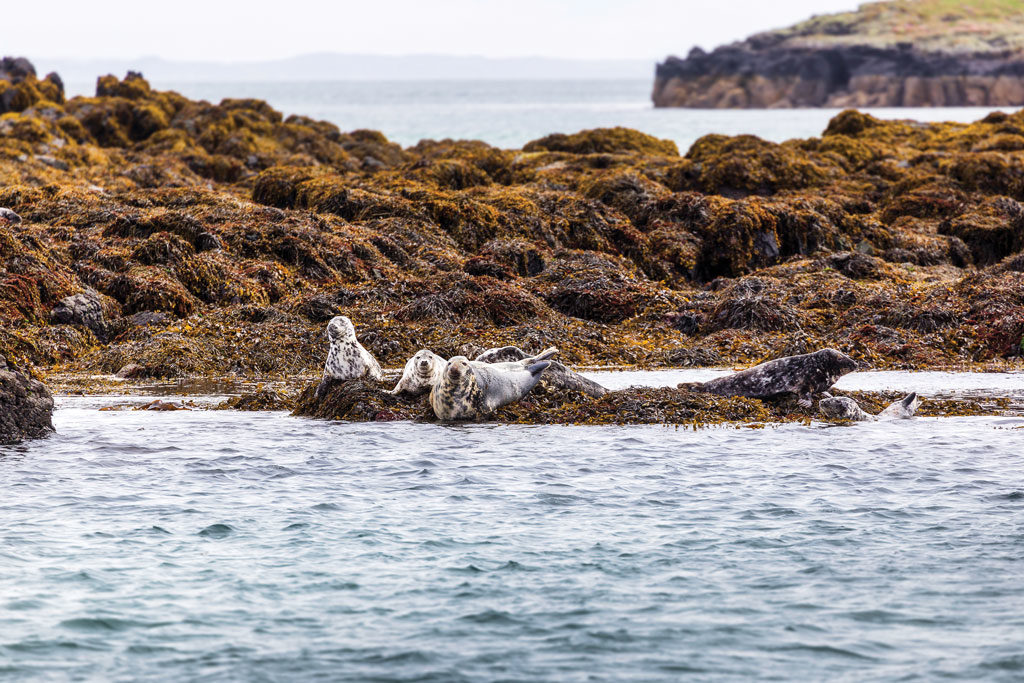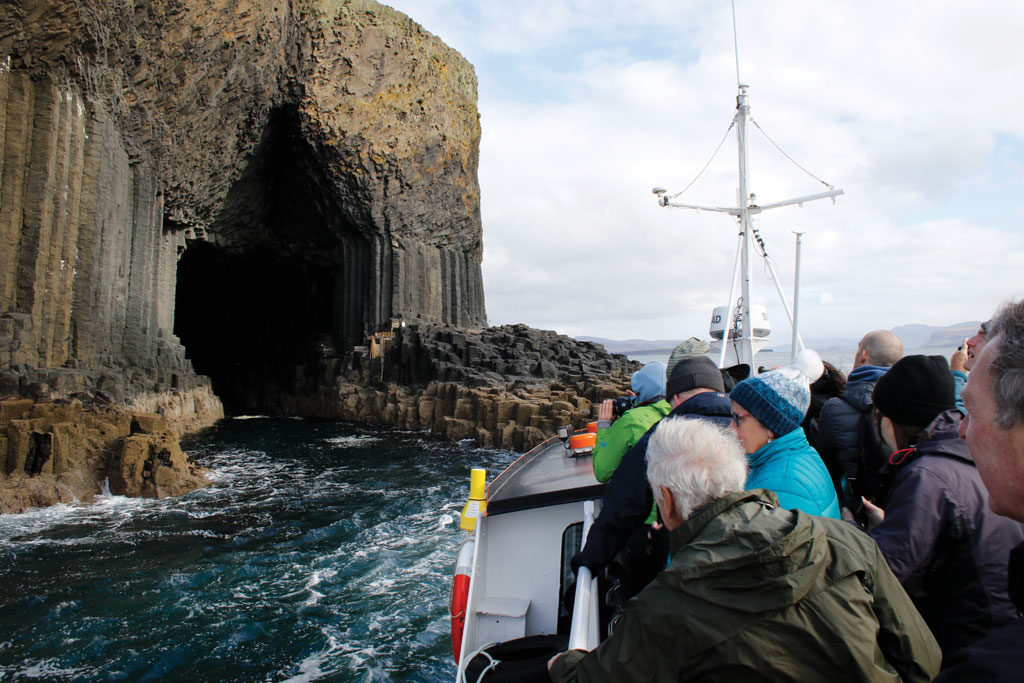Scotland is home to around a third of the world’s grey seals, here’s where to find them…
MORE FROM SCOTLAND MAGAZINE
You could be forgiven for abandoning efforts to pronounce the Gaelic names of the numerous skerries, islets and reefs we pass as we head out to find some of the 1,200 Atlantic grey seal pups born annually on the Treshnish Isles, off the west coast of Scotland.
Grey seal pups are actually born white. This luxuriant fur is called ‘lanugo’, the same term given to the downy covering enjoyed by many a newborn human baby. In Scotland, a white overcoat appears a rather odd choice given that there are few, if any, seal pupping beaches that enjoy the snow and ice that would seem to justify what appears an incongruous choice of camouflage.
The expert view is that unlike their smaller cousins the harbour seals, Scotland’s grey seals are only slowly letting go of the previous Ice Age, which finally began releasing its own grip on our temperate latitude some 15,000 years ago. Another oddity, although understandable given the above, is how late in the year grey seals give birth. Throughout their UK range this can vary between September and December.
So, white it is, at least for the moment. Given the uncertain climatic times in which we live, an evolutionary push to lose the benefit of such an apparent anachronism might even be considered a little premature. Few species make such changes knowingly of course and almost all are at the whim of natural selection. Time and climate change will tell.
I’ve joined a small group of late season visitors to the Inner Hebrides and both we and the seals are enjoying a glorious autumn day. We’re aboard Hoy Lass, a hardy seagoing vessel originally built to ply Orkney’s tricky waters to serve the oil industry.

We plan to land on the stunning island of Staffa and then visit the Treshnish Isles with the hope that we might enjoy a privileged walk ashore in the company of one of the rarest seal species in the world. Although also found in North America and the Barents and Baltic seas, Scotland is a vital habitat. Around a third of the world’s total population of grey seals lives here and our estimated 125,000 animals produce approximately 50,000 pups annually. Population levels do fluctuate but grey seal numbers in the Hebrides currently appear stable.
Although I have been fortunate to visit Staffa on many occasions, it never loses its fascination. But, for me, today is about the seals. I’m in the minority. Most are aboard to visit Staffa’s iconic Fingal’s Cave.
I chat with our small group and am thrilled to discover that one of my fellow passengers is none other than Felix Mendelssohn’s great, great grand-daughter on a pilgrimage to the place that inspired her great, great grandfather’s world-famous Hebrides Overture. As skipper Iain Morrison pokes Hoy Lass’s bow into the entrance of what islanders long-ago named the ‘melodious’ or ‘musical’ cave, I am delighted to hear Anne Mendelssohn humming along with great, great gusto to her ancestor’s very familiar music emanating from the boat’s PA system. This most magnificent of nature’s echo chambers has a six-storey-high basalt column facade and is 230 feet in length, ensuring an evocative medley of surf and gathered strings.
Staffa is steeped in folklore and legend. The same can be said of grey seals across North Atlantic coastal communities. Originating in Shetland and Orkney, Scotland’s own incarnation is the ‘selkie’. A shape-shifting, supernatural being able to shed its seal skin and adopt a human form and life, the selkie lacks the malevolence of its freshwater equine cousin the ‘kelpie’. Stories of selkies entwine loss and longing with seduction and coercion in a melancholic web that undoubtedly held a mirror to life’s hardships and perhaps even sought to explain illness and deformity. Some also believe them to be the souls of the drowned.
Such beliefs afforded grey seals a degree of protection in the past and more recently all seal species have benefitted from some of the UK’s first wildlife protection laws. However, as a top predator they have inevitably attracted opprobrium from another voracious exploiter of marine resources: man. Individual seals can still be shot under licence if interfering with Scotland’s financially important fish-farming industry. Culls have been consistently rejected as the science simply does not support claims of significant damage to fishery interests – local opinion is bitterly divided.
Our own hunt for seals is wholly benign. However, as females will readily abandon pups, great care must be exercised in any activity focussed on seal tourism.
Spotting conditions are favourable with a clement sea and a landing-friendly tide. We zig and zag among the dotted Treshnish islets with skipper Iain pointing out wildlife, geological features and the historical significance of the Carnaburg Islands, utilised for thousands of years and last garrisoned during the Jacobite Uprising of 1715.
There appear to be seals everywhere. Looking around at the very obvious wriggling white blobs, it’s clear why researchers utilise aerial photography to census pup numbers on beaches such as these. The habitat appears perfect and it’s no surprise to learn that this whole area is now a designated Special Area of Conservation for grey seals.

Passing a grassy islet, Iain suggests we lift our gaze from the rocks to where pups and mothers are resting surprisingly high up. There’s clearly safety away from the immediate and busy shore where Hebridean storms and hormone-driven 300kg bull seals can sweep away all before them.
Harbour seal youngsters are ready to swim at birth, but grey seal pups are less happy in water until losing their white coat after weaning at three weeks. Sadly, poor weather takes a heavy toll on new pups.
Our boat rounds a point revealing a deep inlet with gently shelving shores covered in females and pups. We edge in slowly for a closer look but retire without fuss a few minutes later. Next, we move to a less populated spot and sidle up to a convenient vertical rock, perfectly placed for our boat’s portside exit. Here, we are treated to a little time ashore in the seals’ presence. We move cautiously and respectfully but the adults know we’re there and shift their watery gaze between us. The pups seem unbothered and calm descends again as we settle down to compose photographs or simply enjoy this privileged proximity.
All too soon Iain calls us to Hoy Lass and we reluctantly boulder-hop back to our lift home.
Over our shoulders the seals shrug off this somewhat baffling interlude and return to the serious business of raising their next generation. The most brilliant end to my greyest day ever.
Read more:
Five of the best contemporary art galleries in Scotland
Best hotels in Scotland for Christmas and Hogmanay
Princess Anne’s love for Scotland
MORE FROM SCOTLAND MAGAZINE

SCOTLAND MAGAZINE
Published six times a year, every issue of Scotland showcases its stunning landscapes and natural beauty, and delves deep into Scottish history. From mysterious clans and famous Scots (both past and present), to the hidden histories of the country’s greatest castles and houses, Scotland‘s pages brim with the soul and secrets of the country.
Scotland magazine captures the spirit of this wild and wonderful nation, explores its history and heritage and recommends great places to visit, so you feel at home here, wherever you are in the world.